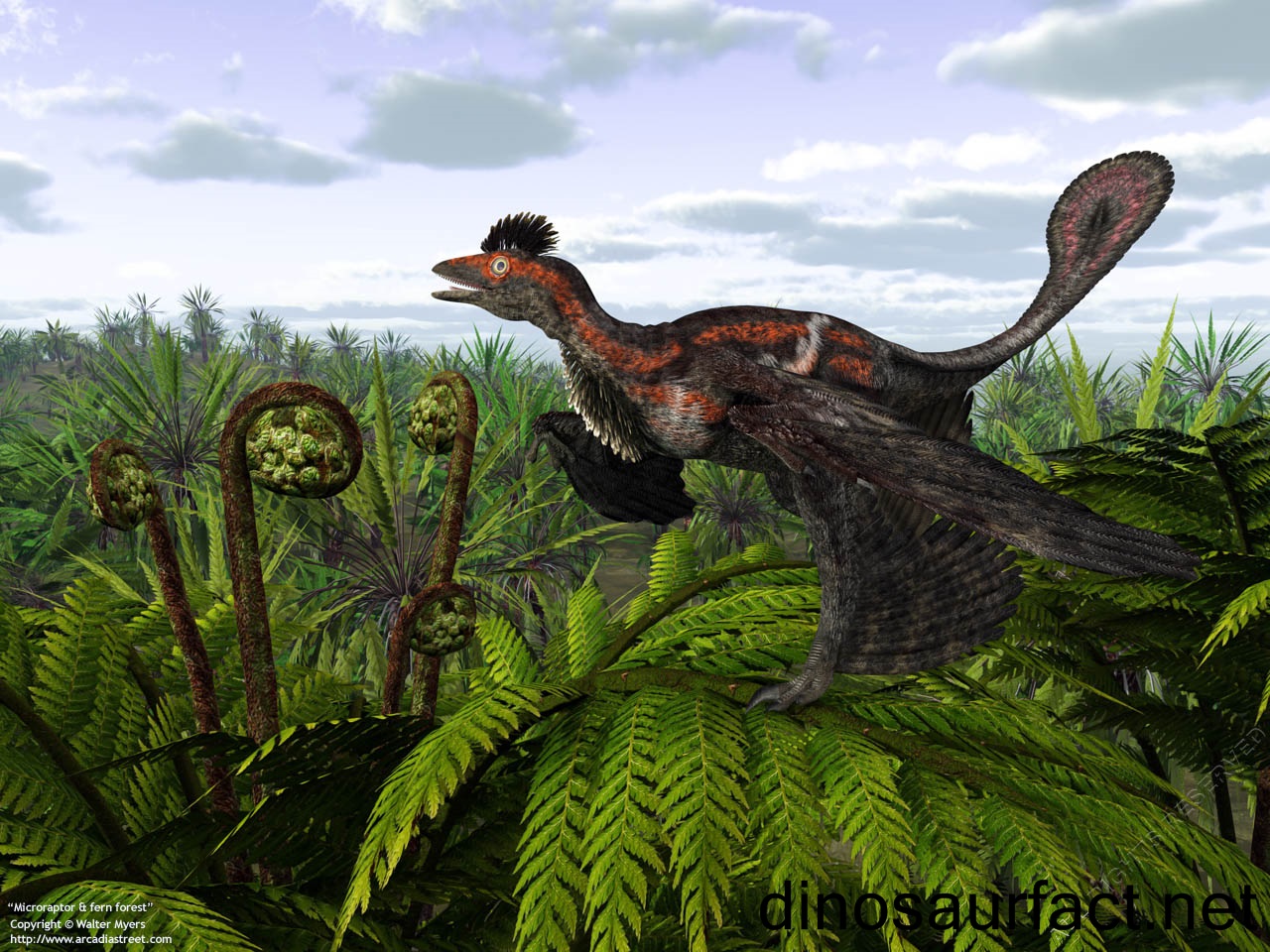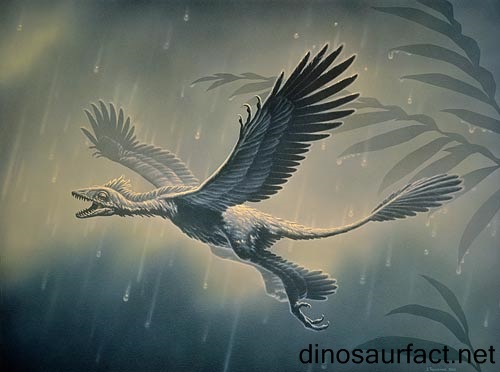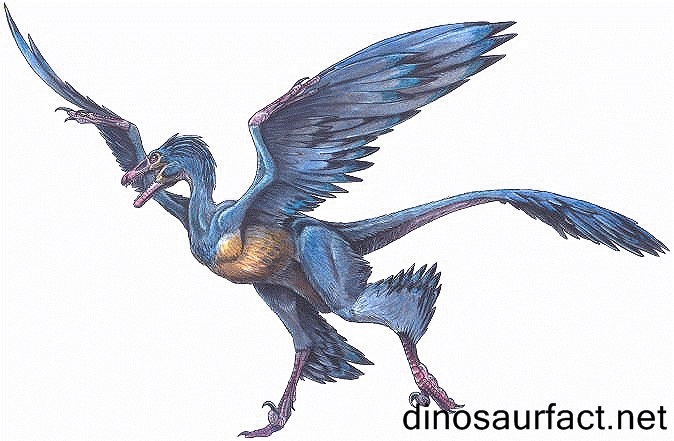 Click to visit the previous Pterosaurs bio
Click to visit the previous Pterosaurs bio
 |
|
 |
|
Kingdom: Animalia
Phylum: Chordata
Order: Theropoda
Family: Dromaeosauridae
Genus: Microraptor
 |
|
 |
|
 |
|

The Microraptor was a small dinosaur that was discovered in China. It existed on the earth in the about 125 to 119 million year ago. This time period lies in the early Cretaceous period of the Mesozoic Era, in the Aptian age.
This dinosaur belongs to the dromaeosaurid group of dinosaurs, which includes famous dinosaurs such as the Velociraptor and the Deinonychus. It is the smallest known member of this group and is also one of the smallest known non avian dinosaurs. It was the size of modern day kites and weighed even less than a fully grown chicken.
One of the most prominent features of the Microraptor was that it consisted of feathers both on its forelegs as well as hind legs. This gave it a four winged appearance. It is not yet clear if this dinosaur could fly like modern birds or merely glide from one tree to another, but its feathers resembled the true flight feathers of modern birds. This has resulted in scientists contemplating the origin of birds. Scientists are now considering if the ancestors of birds had to undergo a four winged stage before attaining a proper two winged flight pattern. Some have even suggested that the flying ability of the Microraptor was better than that of the Archaeopteryx.
Like all other dromaeosaurids, the Microraptor was meat eating dinosaur. It derived its nourishment from mammals, smaller birds and fish.
Etymology
The Microraptor was named for its small size. The prefix ‘Micro’ is derived from the Greek word ‘mikros’ which means small. The suffix ‘raptor’ translates to ‘thief’ or ‘plunderer’ from Latin. Thus, the name of this dinosaur means ‘the small robber’.
Controversy over nomenclature
When the remains of the Microraptor were first discovered, they were smuggled to the United States with many other dromaeosaurid bones. As a result, an article appeared in the National Geographic magazine about the missing link between ‘dinosaurs and flying birds’ and it was named the Archaeoraptor liaoningensis. The curator of the National Museum of Natural History of the Smithsonian, Storrs Olsen, denounced naming a specimen in a magazine without peer review. Paleontologist Xu Xing of China noted that the specimen had contained the tail of a raptor on the body of a Cretaceous bird Yanornis.
Olson, nonetheless, described the tail as genus Archaeoraptor in 1999 in an obscure journal. But Xu recovered the remaining specimen from where the tail was taken and named it the Microraptor zhaoianus.
As Olson did not officially record the name Archaeoraptor, the name Microraptor took precedence.
Discovery of fossils
Many of the fossils of the Microraptor have been recovered from the Jiufotang Formation of Liaoning, China. They were first discovered sometime in 1998.
Currently, the Microraptor is the best represented dromaeosaurid with over 300 known skeletons.
Classification
The Microraptor is currently classified under suborder Theropoda, family Dromaeosauridae and clade Microraptoria. Microraptoria contains the primitive members of the raptor family that were small in size and possessed feathers.
Three species of this dinosaur are described currently, the M. zhaoianus, M. gui and M. hanqingi. All three differed only in size and are hence considered synonyms of the M. zhaoianus.
The genus Cryptovolans is also considered synonymous with the Microraptor presently.
Feathers
The feathers of the Microraptor were long and they were attached to its hind as well as forelegs. The ones on the hands were similar to the fight feathers of modern birds with asymmetrical vanes. The primary feathers were attached to the hands and the secondary to the arms. Due to this arrangement of its feathers, many scientists believe that it was a better flyer than the Archaeopteryx.
Electron microscope scanning techniques have revealed that the feathers of the Microraptor had an iridescent sheen to them and they were black in color. The Microraptor is believed to be a nocturnal dinosaur and no modern nocturnal bird have a shiny coat. Hence the purpose of this sheen is not understood well.
The fight pattern
It seems unlikely that the Microraptor could fly as well as modern birds. Scientists believe that its pectoral girdle and sternum were not adapted to allow it to take off from the ground. It would need to jump from a height to be able to glide; may it travelled from one tree to another this way.
Recent studies by Sankar Chatterjee have posited that the forelegs and hind legs of the Microraptor were held in different planes when it flew. This would require its hind legs to be spread out during flight. Many wind tunnel experiments have been performed using a prototype Microraptor, placing its hind legs various positions. They support the biplane hypothesis. But yet, definitive proof in indeed lacking in spite of these experiments.
Physical features
The Microraptor is one of the smallest known dinosaurs. Its length was about 2.5 to 2.9 feet and its weight was barely 1 kilo. Its build was extremely slender.
Its jaw was like that of typical dromaeosaurids: elongated with sharp teeth. Its teeth were adapted for catching fish.
The forelimbs of the Microraptor were extremely lean. They consisted of three digits which were long and slender.
The hind legs of this dinosaur contained four digits, the second of which possessed the famous sickle claw. Only the third and the fourth digits of the hind limbs touched the ground when the dinosaur walked.
The Microraptor had a very long tail. It was also densely covered with feathers.
Habits and habitat
The Microraptor was most likely an arboreal animal. It glided from one tree to another and possibly seldom walked on land. It was carnivorous. This is judged from the stomach contents of some of the fossilized remains, which have shown mammalian bones, fish scales and even lizards such as the Xianglong. This shows that in spite of its small size, the Microraptor was an efficient hunter just like other dromaeosaurs.
The habitat of the Microraptor consisted of woodlands that had many water bodies. But it is likely that these microenvironments were surrounded by semi-arid plains.
Related and coexisting species
The Microraptor is related to the Hesperonychus, Sinornithosaurus and the Graciliraptor. It probably shared its environment with the Psittacosaurus, Jeholornis, Sinopterus and the Rapaxavis.
The final notes
The Microraptor has shown that birds could have from the ancestors of dromaeosaur dinosaurs. It has also proved that the predecessors of the larger Velociraptor and Achillobator could fly and such dinosaurs likely lost the ability to fly due to their sizes.
Just for fun we have a soundclip available for you to hear what a Microraptor could've sounded like. Click to the Dinosaur Sounds area to hear it. Please note that the dinosaur sounds are only for entertainment and are not an actual fact.
Index
Extinct Profiles
 Triassic Dinosaurs
Triassic Dinosaurs Jurassic Dinosaurs
Jurassic Dinosaurs Cretaceous Dinosaurs
Cretaceous Dinosaurs Pterosaurs
Pterosaurs Marine Reptiles
Marine Reptiles Dinosaur Extinction
Dinosaur Extinction